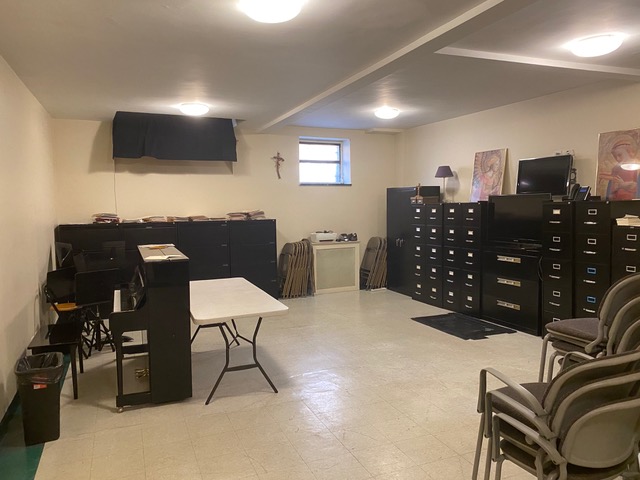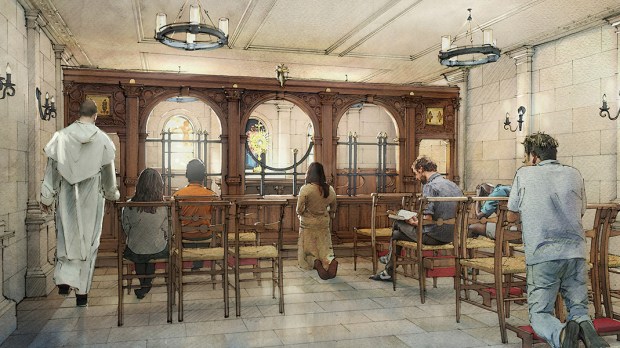In a couple of weeks, folks going to church for Christmas will hear a familiar refrain: “O come, let us adore Him!”
At least one priest in New York City wants to make it so that carol resounds in the hearts of many followers of Christ throughout the year.
Fr. Boniface Endorf, pastor of St. Joseph’s Church in the West Village section of Manhattan, is building a “perpetual adoration chapel” where visitors can spend time in prayer in front of the Blessed Sacrament.
He hopes the parish’s planned Divine Mercy Adoration Chapel will be open by Christmas 2021.
For Catholics, to “adore” Jesus goes far beyond the seasonal sentiment applied to the Babe in Bethlehem. That child grew up, revealed himself as the Messiah, and suffered on the cross as an expiation for the sin of Adam. Before doing so, he left for his disciples a perpetual memorial of his sacrifice, saying over bread and wine at the Last Supper, “This is my body, which will be given up for you,” and “This is the chalice of my blood, the blood of the new and eternal covenant, which will be poured out for you and for many for the forgiveness of sins.”
The bread that becomes the Body of Christ, consecrated by the priest at Mass, is consumed by the faithful, who believe in Christ’s promise that whoever partakes of it will have eternal life. By a long tradition, the Church sets aside some of that consecrated Bread to be taken to anyone who is sick. The need to reserve the sacrament in a special and secure place gave rise to the development of tabernacles. Subsequently came the practice of adoration at times when the liturgy was not taking place.
In the Western Catholic tradition, individual churches, chapels and monasteries have established hours in which the Blessed Sacrament — the consecrated Bread — is displayed in a liturgical vessel called a monstrance (from the Latin monstrare: “to show”). Disciples can spend time in quiet prayer here, meditating on the mystery of the Incarnation and entering into “conversation” with God.
The idea of non-stop adoration
Some churches have even established special places where this prayer takes place non-stop, 24/7, with the monstrance constantly on the altar and a series of “adorers” taking turns to “keep the Lord company.” This is known as perpetual adoration.
From Bethlehem, where Christ was born, to Jerusalem, where he instituted the Eucharist, and throughout the world, such adoration has taken place down through the ages.
And New York City? It’s known as the city that never sleeps. It’s a city of great and beautiful churches, some of which have established times of adoration, holy hours, all-night vigils, and evenings of recollection. But surprisingly, apart from a monastery in the Bronx and a few parishes in the borough of Staten Island, perpetual adoration is rare in the Big Apple. St. Patrick’s Cathedral and a number of other churches offer adoration for several hours daily or weekly, but no church in Manhattan does so 24/7.
“When I was assigned here a little over two years ago, the Young Adult outreach office at the Archdiocese of New York had been going parish to parish, trying to get a pastor to say ‘Okay, we’ll establish perpetual adoration,’” said Fr. Endorf, who belongs to the Order of Preachers, or Dominicans. “I said, ‘What do you mean, you don’t have a perpetual adoration in Manhattan?”
In Fr. Endorf’s mind, St. Joseph’s is a good place to have the devotion. Subway stations near the church, which is on the corner of Avenue of the Americas and West Washington Place, serve several lines from around the Big Apple.
“It’s just about the easiest spot to get to in New York City,” the priest said.
That’s important, as he envisions the chapel serving not just local parishioners but all of New York City.
Young adults
Plus, St. Joseph’s is close to New York University, where his fellow Dominican Friars run the Catholic chaplaincy.
“It was no accident that it was the Young Adult Outreach office that contacted me,” said Fr. Endorf, 43. “Adoration is very popular with young adults. St. Joseph’s has many young adult parishioners, and they are very excited about the chapel. After Mass, many ask me how the project is coming along and tell me that they are praying for its success.”
Fr. Endorf recently finalized design plans with architect Daniel A. Ezekiel Balan, and after raising funds this winter, he expects to begin building the chapel next summer, with completion hoped for by next Christmas.
The 540-square-foot space to be used is currently a storage room in the building next to the church, which has the parish office and rectory upstairs. Fr. Endorf estimates the cost will be between $500,000 and $700,000.

An excessive amount to spend in a time when many people, including many of St. Joseph’s neighbors, are struggling with unemployment and homelessness? Fr. Endorf believes the cost will be well worth it.
“We want people to walk off the mean streets of Gotham into the Heavenly Jerusalem,” he said. “We don’t want it to feel like a dumpy basement. We want it to be a gorgeous chapel that’s looks like it’s been there forever.”
As architect Balan describes it, the design is meant to provide a “fitting place to be perpetually present with our Lord as he is exposed in the most holy sacrament of the altar in the heart of the city that never sleeps.”
”Within the chapel itself, the irregular walls and windows of the existing room are made straight and orderly to frame both seating and sanctuary in a unified space,” he wrote for the chapel’s website. “The sanctuary is situated on the east wall, so that sunrise will shine from the direction of the stone altar through two arched windows that flank the altarpiece.”
Rood screen
Setting the sanctuary apart from the seating area will be a traditional partial-height rood screen of carved wood. (Rood is the Anglo-Saxon word for cross; these wooden screens setting the sanctuary apart from the nave are traditionally topped by a carved representation of the crucifixion, with Mary and St. John at the foot of the cross.) In addition to providing security for the monstrance, the screen will also provide a choir space for the Dominican friars, who will chant their Morning and Evening Prayer there.
“The rood screen is itself a work of art, framing views to the monstrance and representing the reality therein through a symbolic expression of the gates of the new Eden and the transition between Heaven and Earth,” Balan wrote.
Fr. Endorf said that in spite of the cost of building the chapel, beauty — and the union with God to which it points — is priceless.
“Beauty points beyond the seen to the unseen, to realities existing beyond this world, to the realities of heaven itself,” he said. “We cry because we desire the eternal and transcendent realities encountered in beauty; we want the joy of eternity, not the brief encounter of an unexpected moment. We want to pierce the veil to encounter God Himself. Beauty strikes a chord in our hearts because it accords with what our hearts truly seek — not something merely in this world, but a deeper and eternal reality beyond, something only hinted at here below.”
The perpetual adoration chapel, he trusts, will be a place of deep encounter for many.
“To love someone we must know him,” the priest said. “That is the point of prayer — to come to know and love God. Love requires time spent together, and that is what adoration is: spending time with Jesus. Time in adoration is thus time in transformation. It enters us into spiritual and heavenly realities that slowly remake us from within to be children of God and citizens of heaven.”

